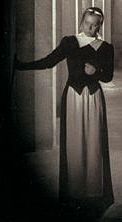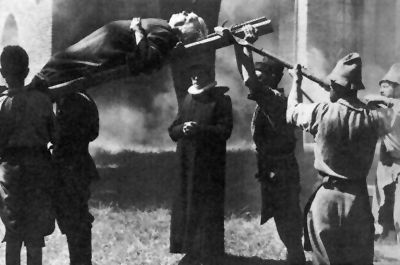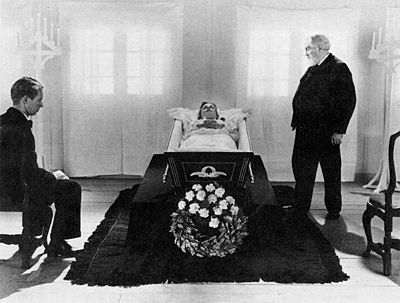 |
 |
|||
 |
 |
|||
Film has always been considered something of a mongrel art form, inherently populist and therefore of dubious aesthetic value, and lacking even a firm identity since it’s distilled from other arts such as photography and the theatre. One effect of this axiom has been a severe lack of standards in ranking films and filmmakers. After the brief A-list of Welles, Renoir, Eisenstein, and a few others, the waters become murky -- so much so that essentially minor-league talents like Steven Spielberg and George Lucas are spoken of with the kind of awe that other arts reserve for their grand masters. Literateurs know junk when they see it -- who would put Anne Rice in the same league as James Joyce? No music lover would claim Yanni or John Tesh is another Stravinsky. Fans of the visual arts don’t argue about whether Jeff Koons or Walter Keane occupies the same cultural space as Picasso or Jackson Pollack. Only in film has it become axiomatic, at least outside cultish realms and the academy, that commercial success equals artistic value -- a fact brought home every year by that tired parade known as the Academy Awards.
One grand master who’s become a casualty of this confusion is Carl Dreyer, the Danish cineaste best known for his ground-breaking silent film The Passion of Joan of Arc. Dreyer made only a handful of films in his 45-year career, and only four acknowledged sound films: Vampyr, Day of Wrath, Ordet (The Word), and Gertrud. These were independent works, shot mostly with actors unknown outside Denmark, dismissed as perverse and uncommercial and thus poorly distributed beyond Europe. Dreyer’s slow, deliberate, gorgeously lit stories about vampires, witch trials, resurrection, faith, and infidelity were mostly rejected as old-fashioned even when they debuted; and it’s true that he worked in conservative forms such as the chamber play, and with demanding stylistic strategies such as the long take. But more than any director, Dreyer is sui generis, and his films now belong among the most daring in cinema, with a visionary power that makes them unique.
Dreyer’s own history made his status as an outsider inevitable. He was born in 1889, the illegitimate son of a housekeeper who died during a desperate self-induced abortion. Dreyer was raised in a succession of foster homes until he was adopted by a poor family. He recalled his early life as one of material and emotional deprivation. His friend Ebbe Neergaard once said the boy’s adopted family "never ceased to let him feel that he ought to be grateful for the food he was given, and that he really had no claim to anything, considering that his mother had managed to escape paying for him by departing this world." Emotional alienation and especially the plight of a strong woman suffocated by social norms would form the basis of much of his later work. In 1908, at age 17, he began writing theatre reviews and eventually film critiques, covering Denmark’s then-burgeoning movie industry. This led to his first screenwriting credit in 1912 and seven years later to his first film, The President. After a series of historical melodramas a la Griffith (Leaves from Satan’s Book) and pastorales (The Parson’s Widow), Dreyer made Mikael (1924) for UFA in Berlin. This is an early gay triangle drama, with an eminent painter losing his inspiration and eventually his life when his young male protégé falls in love with a woman.
In 1927, Dreyer directed the first of his acknowledged masterpieces, the mesmerizing The Passion of Joan of Arc. The director’s passion for detail and realism led him to use the actual transcripts from the trial as the basis for his script. The film, a commercial failure, was considered seminal in its unsparing use of extreme close-ups, but it also created Dreyer’s reputation as a tyrant on the set, driving his star, Falconetti, into mental collapse in his attempts to get the intensely emotional effects he wanted. Vampyr (1932) showed another kind of dreamscape of which Dreyer was capable -- this time the result, in part, of letting the sun actually shine on the camera lens during shooting. This gave the film an ethereal, otherworldly quality that drew critical praise and, again, commercial indifference. Dreyer’s reputation as argumentative and uncompromising continued to grow, and he was unable to secure funding for any projects for another ten years. In 1942 he shot a brief educational film on unwed mothers, a subject that recalled his own origins. Chastened after his long hiatus, he delivered the film on time and within budget and was rewarded with money to shoot Day of Wrath in 1943. This story follows a witch hunt through a 17th-century village, with the parson’s wife Anne trying to save an old woman from being burned at the stake and ending up denounced herself. Critics of the time read the film as an anti-Nazi allegory, but modern viewers will see more timeless effects in Dreyer’s Rembrandt-like compositions and lighting, his fluid camera movement, and above all, the sexually supercharged performance of Lisbeth Movin as Anne, whose sensuality is equated by the narrow minds around her with satanic power.
VHS cover artwork After one disowned feature (Two People, 1944) and a string of shorts, Dreyer secured financing for what many regard as his crowning work, Ordet (1956). Based on a play by Lutheran minister (and Nazi victim) Kaj Munk, the film is a wrenching study of the spiritual desolation and intricate emotional relationships in a rural household. Morten Borgen is the old patriarch of a farm run by his two sons Michel and Anders. A third son, Johannes, has had a mental breakdown and believes he’s Jesus Christ. Michel’s wife, Inger, and their two daughters complete the household. In a scene reminiscent of what happened to Dreyer’s own mother, Inger becomes desperately ill in childbirth. The possessed Johannes predicts her death, and she dies. Prompted by her daughter, Johannes commands Inger to rise from the dead, and she does.
Dreyer's use of light and shadow fantastically evokes the film’s two worlds -- the darkness represented by the Borgens’ lack of faith, Johannes’s insanity, and Inger’s death; and the light represented by Inger’s radiance, kindness, and sexuality, which transcend mortality. Her resurrection, defying narrative logic, is an extraordinary affirmation of love over human limitations. In one of the great moments in all of cinema, she rises, hungrily kissing her overwhelmed husband as if she were famished by death.
Dreyer’s career ended in 1964 with Gertrud, the story of an opera singer who discards a series of lovers over a period of years. Here Dreyer’s style has been pared to its dreamy essence -- extraordinarily long takes, a few simple interiors, a handful of characters. Ordet showed the solace of nature in its restless surveys of the landscape around the Borgen farm; in Gertrud, the landscape is a series of emotionally charged interiors that reflect Gertrud’s rich imaginative life far from nature, resonating through the power of her personality, with little regard for the outside world. Dreyer had other projects in mind, including Medea (eventually made by Lars von Trier from Dreyer’s script) and a life of Christ (for which the screenplay exists). Gertrud was reviled by French critics on its release (the Cannes audience screamed their displeasure and many filmgoers apparently walked out), but its star eventually rose -- alas, too late for Dreyer, who died in 1968.
Now, thanks to Home Vision Cinema, these latter three films have finally been released on tape in decent prints after years of circulating in often well-intentioned but ghastly dupes. No DVD versions (yet) and thus no extras here, but these are clear transfers with an acceptable number of artifacts. Obviously taken from solid source materials with good sound, Dreyer’s three sound masterpieces are welcome indeed.
Day of Wrath, Ordet, and Gertrud are now available on VHS from Home Vision Cinema. This is the first official release of these titles on home video. Suggested retail price: $29.95 each. No current plans exist to release these titles on DVD. Ordet and Gertrud are also available in a three-tape set along with Dreyer's masterpiece The Passion of Joan of Arc. Suggested retail price: $74.95
|




